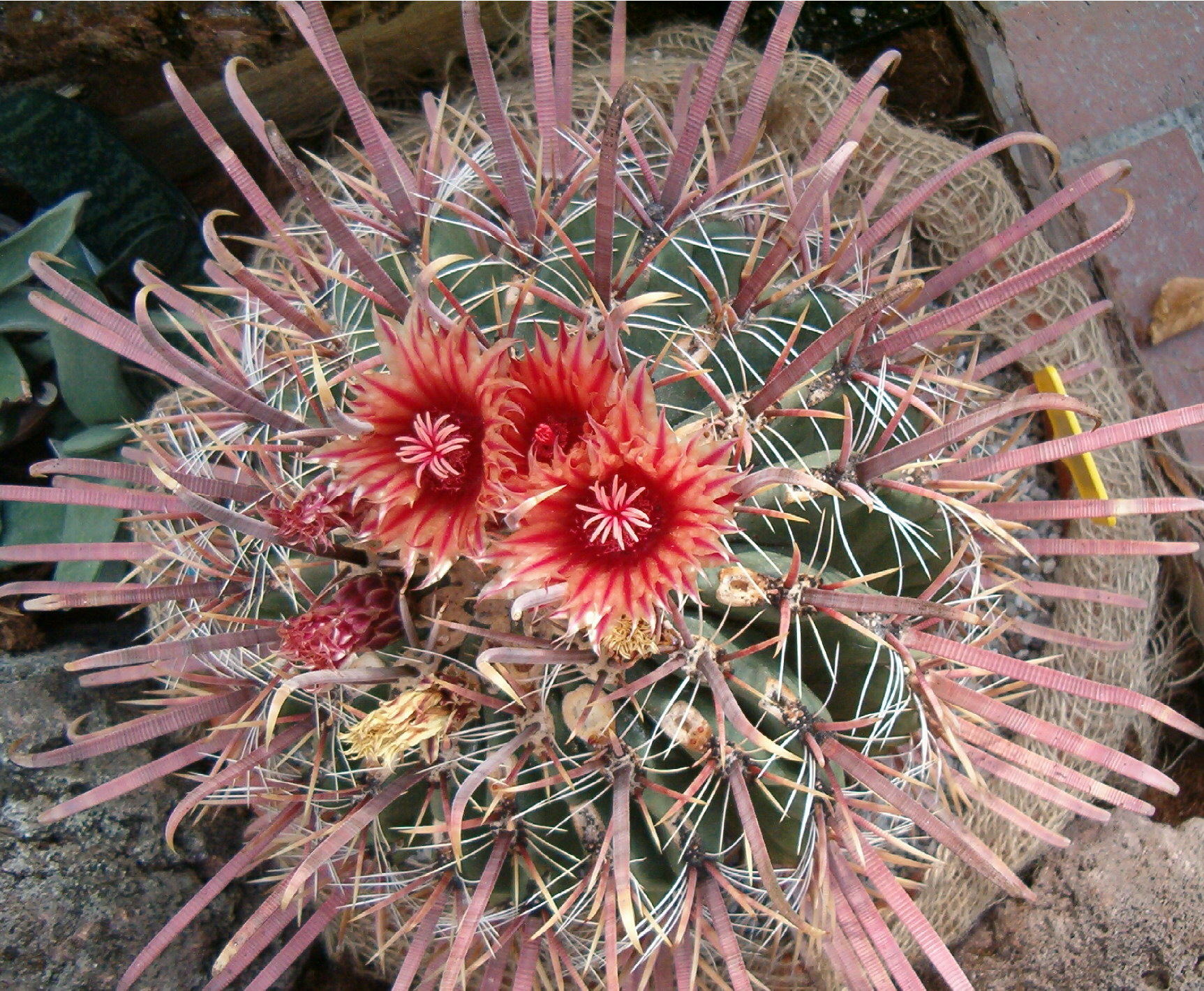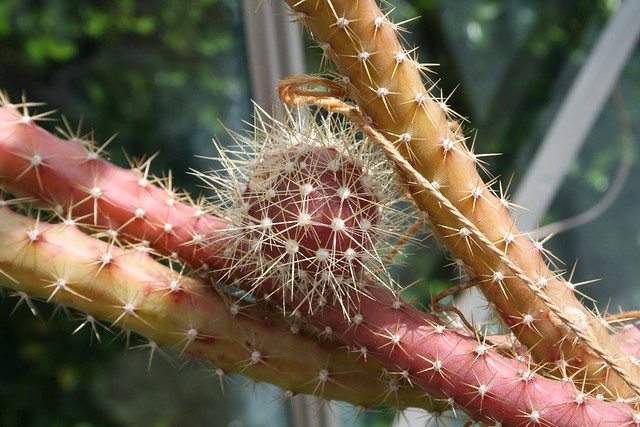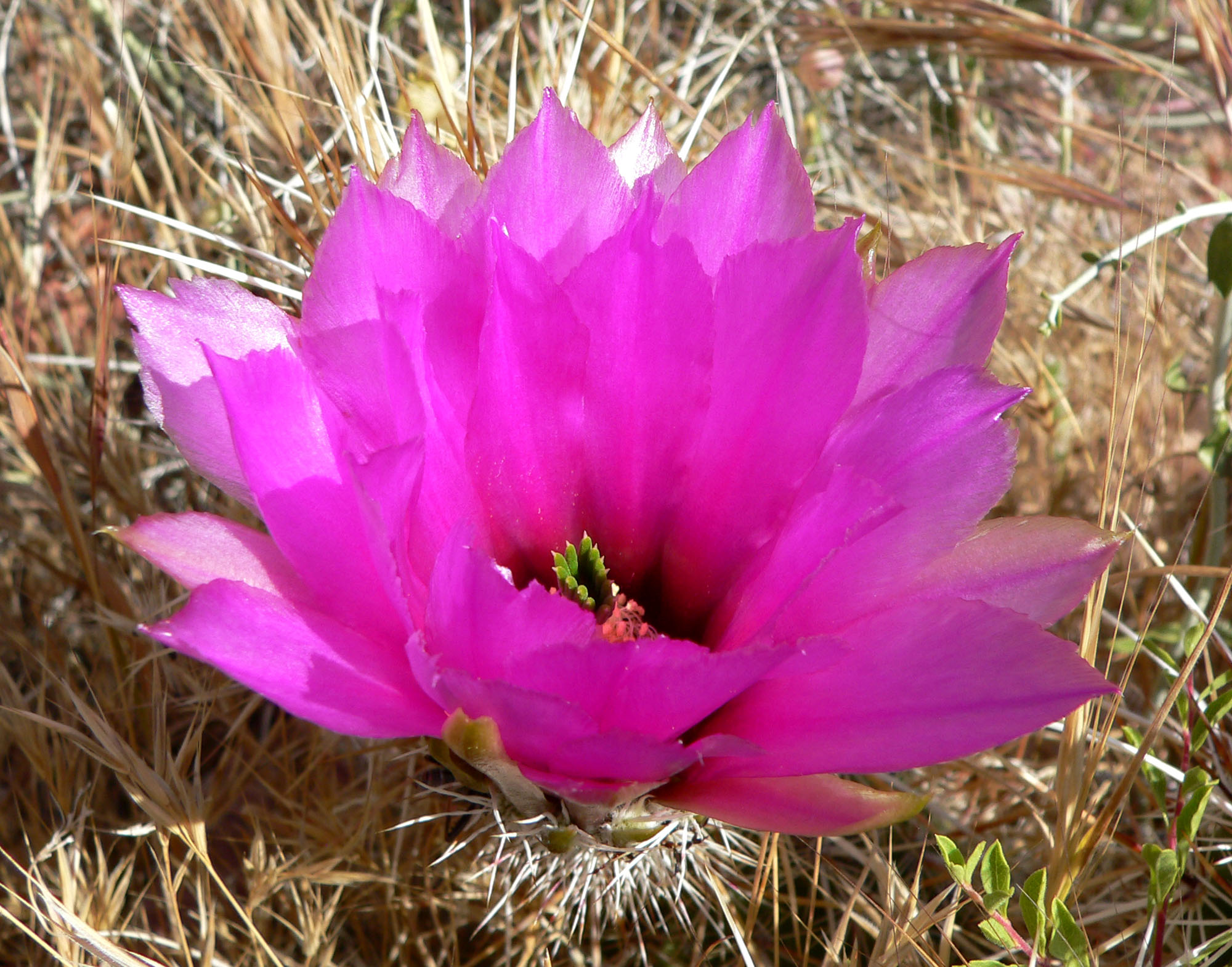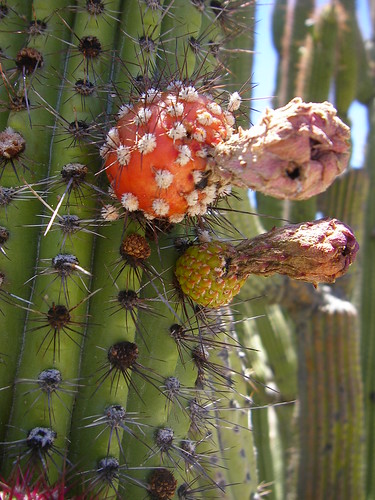 Ferocactus hamatacanthus is widespread in the Chihuahuan Desert of Northwestern Mexico, New Mexico, and Southwestern Texas. The Ferocactus hamatacanthus Type Locality was found in Mexico.
Ferocactus hamatacanthus is widespread in the Chihuahuan Desert of Northwestern Mexico, New Mexico, and Southwestern Texas. The Ferocactus hamatacanthus Type Locality was found in Mexico.
 Ferocactus hamatacanthus forms to be solitary, usually a globular to oblong shape, and grows up to 60 centimetres (24 in). This plant contains 13 ribs normally, but can sometimes be around 17. These ribs of the cactus are strongly tubercled and are generally 2 centimetres (0.79 in) to 3 centimetres (1.2 in) high. Its aeroles are large and 1 centimetre (0.39 in) to 3 centimetres (1.2 in) apart. There are about 12 radial spines, 5 centimetres (2.0 in) to 7 centimetres (2.8 in) long, that are acicular and terete. However, there are fewer central spines, only 4, that tend to be angled and elongated at around 15 centimetres (5.9 in). One of the central spines is hooked at its apex as well.
Ferocactus hamatacanthus forms to be solitary, usually a globular to oblong shape, and grows up to 60 centimetres (24 in). This plant contains 13 ribs normally, but can sometimes be around 17. These ribs of the cactus are strongly tubercled and are generally 2 centimetres (0.79 in) to 3 centimetres (1.2 in) high. Its aeroles are large and 1 centimetre (0.39 in) to 3 centimetres (1.2 in) apart. There are about 12 radial spines, 5 centimetres (2.0 in) to 7 centimetres (2.8 in) long, that are acicular and terete. However, there are fewer central spines, only 4, that tend to be angled and elongated at around 15 centimetres (5.9 in). One of the central spines is hooked at its apex as well.
 This cactus' flowers are large, usually 7 centimetres (2.8 in) to 8 centimetres (3.1 in), and display a yellow color with an inner scarlet color in some forms. This cactus also produces a fruit that is oblong, 2 centimetres (0.79 in) to 5 centimetres (2.0 in) long, fleshy, edible, and a dark brown to drab-color (not red). In addition to these features, its seeds are pitted.
This cactus' flowers are large, usually 7 centimetres (2.8 in) to 8 centimetres (3.1 in), and display a yellow color with an inner scarlet color in some forms. This cactus also produces a fruit that is oblong, 2 centimetres (0.79 in) to 5 centimetres (2.0 in) long, fleshy, edible, and a dark brown to drab-color (not red). In addition to these features, its seeds are pitted.
Ferocactus peninsulae is a barrel cactus in the genus Ferocactus belonging to the family Cacteae. Ferocactus gracilis is a globular to cylindrical solitary cactus growing up to Up to 150 cm tall, 30 cm in diameter.
Blooms in summer, flowers are diurnal red or usually golden yellow with reddish mid-stripe.
 Slow growing to start but does well under cultivation. Use very draining soil, water during the aestival growth cycle (this plant need plenty of water) But needs to be avoided wetting the bodies of these plants while they are in sunlight. A wet cactus in the sun light can cause sun burning which can lead to scares or even fungal infections and death.
Needs full sun. Keep dry at 10°C in winter, but can tolerate sporadic light frost.
Slow growing to start but does well under cultivation. Use very draining soil, water during the aestival growth cycle (this plant need plenty of water) But needs to be avoided wetting the bodies of these plants while they are in sunlight. A wet cactus in the sun light can cause sun burning which can lead to scares or even fungal infections and death.
Needs full sun. Keep dry at 10°C in winter, but can tolerate sporadic light frost.
Ferocactus viridescens is a rare species of barrel cactus known by several common names, including Coast barrel cactus and San Diego barrel cactus. It is native to southern California and northern Baja California. Most of its native range is in San Diego County, California, where it is threatened by development, agriculture, and other alterations in its habitat.

 This cactus is spherical, oblate, or nearly cylindrical, is usually wider than tall, and less than 30 centimeters in height. The flesh is bright green and arranged into several ribs covered in arrays of long spines. The spines stick straight out and may curve a bit, and are red when new, dulling to gray or tan. The cactus blooms in yellow to greenish flowers with red or pink scales. The fruit is yellow or red.
This cactus is spherical, oblate, or nearly cylindrical, is usually wider than tall, and less than 30 centimeters in height. The flesh is bright green and arranged into several ribs covered in arrays of long spines. The spines stick straight out and may curve a bit, and are red when new, dulling to gray or tan. The cactus blooms in yellow to greenish flowers with red or pink scales. The fruit is yellow or red. Cultivation: They are summer-growing and pretty easy plants thought slow to start. They are suited for any rich, well drained soil such us clay, pumice, lava grit, and only a little peat or leaf-mould. If potted, repot them preferably in the spring, if their roots become cramped.
Cultivation: They are summer-growing and pretty easy plants thought slow to start. They are suited for any rich, well drained soil such us clay, pumice, lava grit, and only a little peat or leaf-mould. If potted, repot them preferably in the spring, if their roots become cramped.
Generally, they should be repotted every other year in order to provide fresh soil. However, this doesn't necessarily mean they'll need larger containers. Fill about a quarter of the pot with broken crocks, gravel, etc. to promote good drainage. After repotting, do not water for a week or more. Water regularly during the aestival growth cycle (this plant need plenty of water, but do not overwater and let their soil dry out between waterings), and also needs to be avoided wetting the body of this plant while it is in sunlight.
A wet cactus in the sunlight can cause sun burning which can lead to scares or even fungal infections and death, keep rather dry in winter. No water should ever be allowed to stand around the roots. Feed with a high potassium fertilizer in summer.

 This plant grows in pinyon-juniper woodland and Chihuahuan Desert grassland habitat, usually amidst grama grass (Bouteloua spp.), especially blue grama (Bouteloua gracilis). It is often hard to see the cactus because its spines look like the leaves of the grass.
Sclerocactus papyracanthus is a species of cactus known by the common names grama grass cactus, paper-spined cactus, and toumeya. It is native to North America, where it occurs from Arizona to New Mexico to Texas and into Chihuahua, Northeastern Mexico.
This plant grows in pinyon-juniper woodland and Chihuahuan Desert grassland habitat, usually amidst grama grass (Bouteloua spp.), especially blue grama (Bouteloua gracilis). It is often hard to see the cactus because its spines look like the leaves of the grass.
Sclerocactus papyracanthus is a species of cactus known by the common names grama grass cactus, paper-spined cactus, and toumeya. It is native to North America, where it occurs from Arizona to New Mexico to Texas and into Chihuahua, Northeastern Mexico.
 Sclerocactus papyracanthus is small cactus grows up to 8 centimeters tall by 2.5 wide. It is covered in so many spines they obscure the stems beneath. They are white, tan, or gray in color, papery in texture, and sometimes twisted or wavy in shape.
The actual shape of the flower is an oval pedal. The flower is up to 2.5 centimeters long and have light-colored outer tepals with dark midstripes. The fruit is green and dry at maturity.
Sclerocactus papyracanthus is small cactus grows up to 8 centimeters tall by 2.5 wide. It is covered in so many spines they obscure the stems beneath. They are white, tan, or gray in color, papery in texture, and sometimes twisted or wavy in shape.
The actual shape of the flower is an oval pedal. The flower is up to 2.5 centimeters long and have light-colored outer tepals with dark midstripes. The fruit is green and dry at maturity.

Selenicereus spinulosus is a cactus species native to eastern Mexico and, possibly, the lower Rio Grande Valley of Texas in the United States. Common names include Spiny Moon Cereus and Vine-like Moonlight Cactus. Its specific name, spinulosus, means "spiny" in Latin and is unusual for a plant with relatively short spines.
This was the third species of Selenicereus to be discovered. It was originally collected by Thomas Coulter in 1827, in Mexico, but no locality is known. Pyramus de Candolle received the plant in Paris and descripted it without knowing its flowers. He later sent cuttings to Berlin where it flowered the first time in 1842.
 This species is found in eastern Mexico from Tamaulipas to Chiapas. Plants were collected from the lower Rio Grande Valley of Texas in the United States, but this population may have been extirpated as it has not been seen outside of cultivation in some time.
This species is found in eastern Mexico from Tamaulipas to Chiapas. Plants were collected from the lower Rio Grande Valley of Texas in the United States, but this population may have been extirpated as it has not been seen outside of cultivation in some time.
Stems scandent, clambering or sprawling, branching, producing aerial roots, stiff, to 1-2(-5) m long, 2–3 cm thick; ribs 4-6 or more, later terete, acute; areoles 1,5–2 mm on Ø, reddish brown at first, later greyish brown, internodes 1,5-2,5 cm; spines 6-8, 1 mm long, acicular, white or yellowish, later blackish, radial spines 5-6 central spines 1-2, basally 0,25 mm in Ø above the swollen bases, apically attenuate-conical, circular in cross section, the bulbous bases 0,5 mm in Ø, hairlike spines none; epidermis light green, somewhat shining. Flowers produced from areoles near tip, 8–14 cm long, 7-8,5 cm in Ø, nocturnal but stays open for 2 2–3 days (John Ellis, UK), tepals rotate; pericarpel covered with spines, but no hairs, bracteoles small, triangular, reddish; receptacle ca 5 cm long, green, with clusters of 7-12 spines, 4–5 mm long, brownish, but no hairs; outer tepals 5,5–6 cm, narrowly oblong, acute, brownish; inner tepals 7,5 cm, 11 mm wide, narrowly oblong, acute, white, sometimes with pink base or pinkish throughout; stamens white, much shorter than inner tepals; style yellow, stigma lobes 9-11. Fruit globular, yellow, covered densely with yellowish spines.
 Plants ca 1 m long are capable of flowering. Give half-shade or full sun, and grow in a compost containing plenty of peat. During the growing period this plant needs ample water and regular doses of fertilizer. Fast growing and free flowering. Can be kept at 5°C (41°F) during winter, if kept dry. It is the easiest species to bring to flower in cultivation.
Plants ca 1 m long are capable of flowering. Give half-shade or full sun, and grow in a compost containing plenty of peat. During the growing period this plant needs ample water and regular doses of fertilizer. Fast growing and free flowering. Can be kept at 5°C (41°F) during winter, if kept dry. It is the easiest species to bring to flower in cultivation.
Opuntia microdasys (Bunny Ears Cactus, Bunny Cactus or Polka-dot Cactus) is a species of cactus native and endemic to central and northern Mexico.

Opuntia microdasys forms a dense shrub 40–60 cm tall, occasionally more, composed of pad-like stems 6–15 cm long and 4–12 cm broad.
Opuntia microdasys has no spines, but instead has numerous white or yellow glochids 2–3 mm long in dense clusters; these glochids are barbed and thinner than the finest human hairs, detaching in large numbers upon the slightest touch. If not removed they will cause considerable skin irritation, so the plants must be treated with caution. Despite this, it is a very popular cactus in cultivation.
Glochids should be removed as soon as possible, before the onset of contact dermatitis which may persist for months if left untreated.
To minimize the potential misery, keep your hands wet while dealing with any plant with glochids like this.
The water on your wet skin softens on contact the tips of the very fine glochids,dramatically reducing their ability to actually penetrate the skin and stick. See Removal of glochidia
 This cacti has no central stem or leaves. The individual segments which constitute the cactus body are oval shaped pads from which additional segments form. These new segments always grow in pairs, giving new growth areas the appearance of bunny ears. Newest segments grow in as a red color, and mature to dark green as they grow. Flowers will always sprout from the terminal ends of segment pads.
This cacti has no central stem or leaves. The individual segments which constitute the cactus body are oval shaped pads from which additional segments form. These new segments always grow in pairs, giving new growth areas the appearance of bunny ears. Newest segments grow in as a red color, and mature to dark green as they grow. Flowers will always sprout from the terminal ends of segment pads.
 The Polka-dot Cactus covers its mature pads with closely spaced glochids, or small mounds of prickles that are designed to detach when impacted by something. Once fully formed, the glochids form on the new plant segment. The glochids are so loosely attached that a strong breeze can cause them to go airborne.
The Polka-dot Cactus covers its mature pads with closely spaced glochids, or small mounds of prickles that are designed to detach when impacted by something. Once fully formed, the glochids form on the new plant segment. The glochids are so loosely attached that a strong breeze can cause them to go airborne.
Flowers only bud at the termination points of fully formed segments. Budding begins in late spring, and culminates in early summer with 2 inch wide blossoms. These are a creamy yellow in color, and fade to peach once fertilized. Flowers will turn into 2 inch long fruits varying from purple to red in color. Bloom encouragement is not needed.
The Strawberry Hedgehog Cactus (Echinocereus engelmannii) is commonly found in desert areas of the southwestern United States and the adjacent areas of Mexico, including the states of California, Nevada, Utah, Arizona, Baja California and Sonora. It usually grows in clusters, sometimes up to 20 and more stems. Its bright magenta flowers bloom in April in its southern extremes to late May at northern locations. The flowers are borne at the upper half to one third of the stem.
They are funnelform in shape, up to 3.5 inches long with dark-green stigmas. The fruit is very spiny. At first it is green, becoming pink and drying when ripe. The ripe fruit has spines which are easily detached. The seeds are black, and around a tenth of an inch in size.
The stems are initially cylindrical and erect in young plants, but later with the stem base lying on the ground. The stems are usually 1.5 to 3.5 inches in diameter and up to 25 inches high, and obscured by heavy spines. The plants have around 10 ribs, which are somewhat flattened and tuberculate.
Spines variable in color and size.
 Radial spines are shorter and needlelike, up to 0.8 inch long, white and arranged in a neat rosette. Central spines number 2 to 7 and are stout, usually twisted or angular, up to 3 inches long and variable in color: bright yellow, dark brown, grey, and white.
Radial spines are shorter and needlelike, up to 0.8 inch long, white and arranged in a neat rosette. Central spines number 2 to 7 and are stout, usually twisted or angular, up to 3 inches long and variable in color: bright yellow, dark brown, grey, and white.
 Echinocereus engelmannii is commonly used as a landscape plant in its native areas. In pot culture it requires well aerated gritty substrate, and a hot and sunny location in the summer. In the winter the plant easily tolerates light frost and wet (if well-drained) soil. In cultivation it usually does not bloom until it develops 2-3 branches.
Echinocereus engelmannii is commonly used as a landscape plant in its native areas. In pot culture it requires well aerated gritty substrate, and a hot and sunny location in the summer. In the winter the plant easily tolerates light frost and wet (if well-drained) soil. In cultivation it usually does not bloom until it develops 2-3 branches.
 The Organ Pipe Cactus (Stenocereus thurberi) is a species of cactus native to Mexico and the United States. The species is found in rocky desert. Two subspecies are recognized based on their distribution and height. The Organ Pipe Cactus National Monument is named for the species.
Its English common name is derived from its resemblance to a pipe organ. It is locally known as pitaya dulce, Spanish for "sweet pitaya" or sweet cactus fruit.
The Organ Pipe Cactus (Stenocereus thurberi) is a species of cactus native to Mexico and the United States. The species is found in rocky desert. Two subspecies are recognized based on their distribution and height. The Organ Pipe Cactus National Monument is named for the species.
Its English common name is derived from its resemblance to a pipe organ. It is locally known as pitaya dulce, Spanish for "sweet pitaya" or sweet cactus fruit.
 This cactus species has several narrow stems that rise vertically, growing from a single short trunk just above the ground level. These stems are about 6 inches (15 cm) thick and grow to a height of 16 feet (4.9 m), however it has been known to reach 23 to 26 feet (7.0 to 7.9 metres). These stems rarely branch but rather grow annually from the tip of the last growth. The mature plant can reach a width of 12 feet (3.7 m). Each stem has 12 to 19 1⁄3 inch (0.85 cm) high ribs that bear dark brown to black spines that turn gray as it matures. It takes 150 years to reach maturity.
This cactus species has several narrow stems that rise vertically, growing from a single short trunk just above the ground level. These stems are about 6 inches (15 cm) thick and grow to a height of 16 feet (4.9 m), however it has been known to reach 23 to 26 feet (7.0 to 7.9 metres). These stems rarely branch but rather grow annually from the tip of the last growth. The mature plant can reach a width of 12 feet (3.7 m). Each stem has 12 to 19 1⁄3 inch (0.85 cm) high ribs that bear dark brown to black spines that turn gray as it matures. It takes 150 years to reach maturity.
The older plants produce three-inch (8 cm) funnel-shaped white flowers annually which are open at night and close by the morning and have a purple or pink tint to them. These usually grow during April, May, and June. The organ pipe cactus is usually pollinated by bats. The plant also produces fruit about the size of a tennis ball. Beneath the fruit's spiny exterior is red flesh that has been described as tasting better than watermelon.

This species is found mostly in Mexico, mainly in Sonora and southern Baja California. It is also known to the United States, but is much rarer, with the notable exception of Organ Pipe Cactus National Monument. The plant is predominantly found on rocky hillsides up to 3,000 feet (910 m) in elevation. It is sensitive to frost, so the species is rare in low desert areas, which can be more susceptible to frost. The plant is slow growing, and prefers well-drained soil and full sun. However, when in the seedling stage, it requires shade, and will grow beneath a "nurse tree". It will need this for several years until it grows an adequate root system, which is mostly in the upper 10 cm of soil.
There are two recognized subspecies, the type subspecies, thurberi, is much larger and occurs in southern Arizona, mainland Mexico, and Northern Baja California. The other is littoralis, which is much smaller and usually grows to around 10 feet (3.0 m). It occurs only in southern Baja California.
 Ferocactus hamatacanthus forms to be solitary, usually a globular to oblong shape, and grows up to 60 centimetres (24 in). This plant contains 13 ribs normally, but can sometimes be around 17. These ribs of the cactus are strongly tubercled and are generally 2 centimetres (0.79 in) to 3 centimetres (1.2 in) high. Its aeroles are large and 1 centimetre (0.39 in) to 3 centimetres (1.2 in) apart. There are about 12 radial spines, 5 centimetres (2.0 in) to 7 centimetres (2.8 in) long, that are acicular and terete. However, there are fewer central spines, only 4, that tend to be angled and elongated at around 15 centimetres (5.9 in). One of the central spines is hooked at its apex as well.
Ferocactus hamatacanthus forms to be solitary, usually a globular to oblong shape, and grows up to 60 centimetres (24 in). This plant contains 13 ribs normally, but can sometimes be around 17. These ribs of the cactus are strongly tubercled and are generally 2 centimetres (0.79 in) to 3 centimetres (1.2 in) high. Its aeroles are large and 1 centimetre (0.39 in) to 3 centimetres (1.2 in) apart. There are about 12 radial spines, 5 centimetres (2.0 in) to 7 centimetres (2.8 in) long, that are acicular and terete. However, there are fewer central spines, only 4, that tend to be angled and elongated at around 15 centimetres (5.9 in). One of the central spines is hooked at its apex as well.





